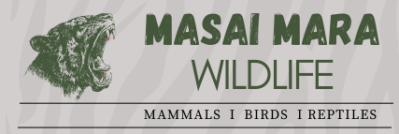- Common Names: Hippopotamus, Hippo
- Scientific Name: Hippopotamus amphibius
- Swahili Name: Kiboko
- Maasai Name: Olmakau
- Size:
- Head-Body Length (HBT): 4.5 m (15 ft)
- Shoulder Height (SH): 1.6 m (5 ft)
- Gestation: 34–35 weeks
Recognition and Appearance
The African Hippopotamus is one of the most iconic mammals in the Masai Mara, characterized by its immense size, blubbery pink and grey-brown body, and massive front teeth. Its large head, heavy, barrel-like body, and short, stumpy legs make it a formidable presence in Africa’s rivers. Despite their bulky frame, hippos are surprisingly fast, capable of running at speeds of up to 48 kph (30 mph) on land.
The large, spear-shaped incisors and recurved canines are made of ivory and are mainly used for fighting, especially during territorial disputes. These social animals live in mixed-sex pods dominated by a bull who presides over a harem of females and defends his territory vigorously.
Habits and Behavior
- Aquatic Lifestyle: Hippos are semi-aquatic, spending most of the day submerged in water to keep cool and avoid the harsh sun. Their eyes, ears, and nostrils are positioned on top of their heads, allowing them to see, hear, and breathe while mostly submerged. They generally leave the water at dusk to graze on land throughout the night, walking up to 8 km (5 miles) in search of grass.
- Nocturnal Grazing: Hippos are primarily nocturnal grazers, feeding on grasses and other vegetation during the night. They can consume up to 40 kg (88 lbs) of plant material in one night. Hippos sometimes nibble on carcass meat, though this behavior is likely a sign of nutritional stress.
- Social Structure: Hippos are highly sociable and live in groups, or pods, which are dominated by an aggressive male bull. Young males are tolerated within the pod only if they display submissive behaviors. During the day, they remain in water, closely packed together, but at night, they disperse to graze on land.
- Aggression and Danger: Despite their seemingly calm nature when in water, hippos are considered one of the most dangerous animals in Africa, especially when they feel threatened or when people come between them and water. They are responsible for numerous human fatalities each year.
Reproduction and Calves
- Mating and Calving: Hippos mate in the water, with the female remaining submerged while the male positions himself on top. After a gestation period of 34–35 weeks, females give birth to a single calf (rarely twins), often in water. Newborns weigh about 30 kg (66 lbs) and can suckle underwater. Calves remain close to their mothers and are fiercely protected within the pod.
- Parenting: Hippo mothers are highly protective of their young, and calves are able to swim almost immediately after birth. Mothers nurse their calves for up to 18 months, and the close bond continues as they grow.
Habitat and Diet
- Where to Find: Hippos are most commonly found in major rivers, lakes, and seasonal pools in the Masai Mara. They thrive in these aquatic environments, where they can cool off and protect their sensitive skin from the sun. During periods of drought, they may suffer from dehydration and skin burns.
- Feeds on: Hippos are primarily grazers, feeding on grasses and rank vegetation. They have also been observed nibbling on carcass meat when food is scarce.
Unique Traits
- Semi-aquatic Adaptations: Hippos are uniquely adapted to life in water, with high-set eyes, ears, and nostrils allowing them to remain mostly submerged while still being aware of their surroundings. Their skin secretes a red, oily substance that acts as a natural sunscreen and antibiotic.
- Dangerous Speed: Despite their enormous size and short legs, hippos are surprisingly fast on land. They are capable of charging at over 48 kph (30 mph), making them a serious threat to anyone who unknowingly gets too close.
- Communication and Vocalization: Hippos are highly vocal, producing a range of sounds, from grunts to the familiar “wheeze-honk” calls that echo across rivers. Males often vocalize to assert dominance and claim territory.
Conservation Status
- IUCN Status: Vulnerable. The African Hippopotamus faces several threats, including habitat loss due to human encroachment and poaching for its ivory-like teeth and meat. Hippos are increasingly affected by conflicts with humans as agricultural expansion encroaches on their habitat, often leading to dangerous encounters.
Interesting Facts
- Sunblock Secretions: Hippos produce a red, acidic secretion from their skin, often referred to as “blood sweat.” This secretion acts as a natural sunscreen, protecting them from harmful UV rays and preventing infections.
- Carcass Consumption: Although primarily herbivores, hippos have been observed chewing on carcasses. This is believed to be due to nutritional stress rather than a true carnivorous tendency.
Role in Ecosystem
Hippos are vital to the ecosystem, as their grazing patterns create hippo trails that lead to water sources for other animals. Their dung enriches the aquatic environment, contributing to the overall health of rivers and streams by dispersing nutrients that support fish and other wildlife.
In conclusion, the African Hippopotamus is both a fascinating and dangerous creature, often seen lounging in the rivers of the Masai Mara. Despite its placid appearance while submerged, its territorial behavior and speed on land make it one of the most formidable animals to encounter on safari. With conservation efforts focusing on habitat preservation and mitigating human-wildlife conflict, hippos remain an integral part of Africa’s wildlife.
